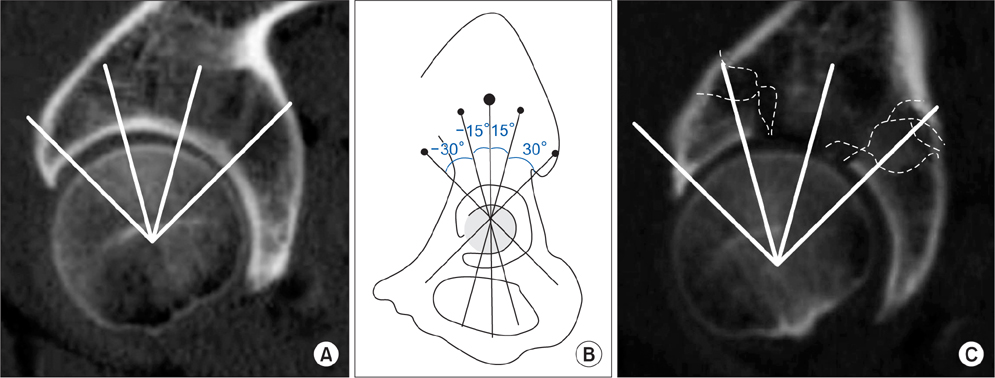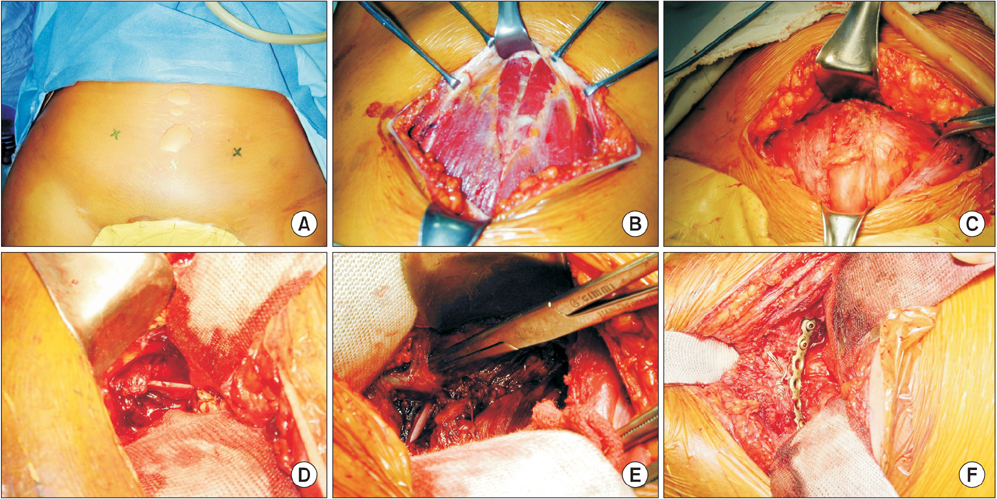Clin Orthop Surg.
2015 Mar;7(1):29-38. 10.4055/cios.2015.7.1.29.
Modified Stoppa Approach for Surgical Treatment of Acetabular Fracture
- Affiliations
-
- 1Department of Orthopedic Surgery, Eulji University Hospital, Eulji University College of Medicine, Daejeon, Korea. yds123@eulji.ac.kr
- KMID: 2069872
- DOI: http://doi.org/10.4055/cios.2015.7.1.29
Abstract
- BACKGROUND
We analyzed the extent of the comminution in the acetabular weight-bearing area, the clinical and radiographic results, and the complications after a minimum 2-year follow-up of the modified Stoppa approach for the treatment of acetabular fractures, and we attempted to evaluate the efficacy of the operative technique.
METHODS
All of the 22 patients, who needed the anterior approach for the treatment of acetabular fractures at our hospital from November 2007 to November 2010, were subjected to surgery via the modified Stoppa approach. Fracture pattern, operative time, blood loss during the operation, quality of reduction, number of bony fragments in the acetabular weight-bearing area, and postoperative complications were assessed by retrospectively analyzing the medical records and the radiographic examinations. The results after the operation were analyzed based on the criteria of Matta.
RESULTS
The clinical results were excellent in 3 cases, good in 13 cases, and poor in 4 cases, while the radiographic results were excellent in 5 cases, good in 13 cases, and poor in 2 cases. Although the quality of reduction and the clinical results according to the extent of comminution were statistically significant (p = 0.03 and p = 0.04, respectively), the radiographic results were not statistically significant (p = 0.74).
CONCLUSIONS
It can be concluded that the modified Stoppa approach could be used as an alternative to the classic ilioinguinal approach. In addition, comminution of the acetabular fracture was an important factor causing non-anatomic reduction and finally unsatisfactory clinical results.
Keyword
MeSH Terms
Figure
Cited by 1 articles
-
Cerclage Clamping Using Cerclage Passer for Reduction of Anterior and Posterior Column Fracture
Ki Chul Park, Hyun Joong Cho, Hun Chul Kim, Kyung-Sik Min, Hae Won Jeong
J Korean Orthop Assoc. 2016;51(6):486-492. doi: 10.4055/jkoa.2016.51.6.486.
Reference
-
1. Letournel E. The treatment of acetabular fractures through the ilioinguinal approach. Clin Orthop Relat Res. 1993; (292):62–76.2. Matta JM. Fractures of the acetabulum: accuracy of reduction and clinical results in patients managed operatively within three weeks after the injury. J Bone Joint Surg Am. 1996; 78(11):1632–1645.3. Min BU, Nam SY, Kang CS. Complications of surgical treatment in patients with acetabular fractures. J Korean Hip Soc. 2000; 12(3):253–260.4. Judet R, Judet J, Letournel E. Surgical treatment of recent fractures of the acetabulum: apropos of 46 operated cases. Mem Acad Chir (Paris). 1962; 88:369–377.5. Letournel E, Judet R. Fractures of the acetabulum. Berlin: Springer-Verlag;1974.6. Andersen RC, O'Toole RV, Nascone JW, Sciadini MF, Frisch HM, Turen CW. Modified stoppa approach for acetabular fractures with anterior and posterior column displacement: quantification of radiographic reduction and analysis of interobserver variability. J Orthop Trauma. 2010; 24(5):271–278.7. Stoppa RE, Rives JL, Warlaumont CR, Palot JP, Verhaeghe PJ, Delattre JF. The use of Dacron in the repair of hernias of the groin. Surg Clin North Am. 1984; 64(2):269–285.8. Rives J, Stoppa R, Fortesa L, Nicaise H. Dacron patches and their place in surgery of groin hernia: 65 cases collected from a complete series of 274 hernia operations. Ann Chir. 1968; 22(3):159–171.9. Cole JD, Bolhofner BR. Acetabular fracture fixation via a modified Stoppa limited intrapelvic approach: description of operative technique and preliminary treatment results. Clin Orthop Relat Res. 1994; (305):112–123.10. Hirvensalo E, Lindahl J, Bostman O. A new approach to the internal fixation of unstable pelvic fractures. Clin Orthop Relat Res. 1993; (297):28–32.11. Judet R, Judet J, Letournel E. Fractures of the acetabulum: classification and surgical approaches for open reduction: preliminary report. J Bone Joint Surg Am. 1964; 46(8):1615–1646.12. Nishii T, Tanaka H, Nakanishi K, Sugano N, Miki H, Yoshikawa H. Fat-suppressed 3D spoiled gradient-echo MRI and MDCT arthrography of articular cartilage in patients with hip dysplasia. AJR Am J Roentgenol. 2005; 185(2):379–385.13. Matta JM. Operative treatment of acetabular fractures through the ilioinguinal approach: a 10-year perspective. Clin Orthop Relat Res. 1994; (305):10–19.14. Matta JM, Anderson LM, Epstein HC, Hendricks P. Fractures of the acetabulum: a retrospective analysis. Clin Orthop Relat Res. 1986; (205):230–240.15. Matta JM, Mehne DK, Roffi R. Fractures of the acetabulum: early results of a prospective study. Clin Orthop Relat Res. 1986; (205):241–250.16. Letournel E, Judet R, Elson RA. Late complication of operative treatment within three weeks of injury. In : Letournel E, Judet R, Elson RA, editors. Fractures of the acetabulum. 2nd ed. Berlin: Springer-Verlag;1993. p. 541–563.17. Borrelli J Jr, Goldfarb C, Ricci W, Wagner JM, Engsberg JR. Functional outcome after isolated acetabular fractures. J Orthop Trauma. 2002; 16(2):73–81.18. Vrahas MS, Widding KK, Thomas KA. The effects of simulated transverse, anterior column, and posterior column fractures of the acetabulum on the stability of the hip joint. J Bone Joint Surg Am. 1999; 81(7):966–974.19. Hirvensalo E, Lindahl J, Kiljunen V. Modified and new approaches for pelvic and acetabular surgery. Injury. 2007; 38(4):431–441.20. Harris WH. Traumatic arthritis of the hip after dislocation and acetabular fractures: treatment by mold arthroplasty: an end-result study using a new method of result evaluation. J Bone Joint Surg Am. 1969; 51(4):737–755.21. Matta JM, Merritt PO. Displaced acetabular fractures. Clin Orthop Relat Res. 1988; (230):83–97.22. Pantazopoulos T, Mousafiris C. Surgical treatment of central acetabular fractures. Clin Orthop Relat Res. 1989; (246):57–64.23. Marsh JL, Buckwalter J, Gelberman R, et al. Articular fractures: does an anatomic reduction really change the result. J Bone Joint Surg Am. 2002; 84(7):1259–1271.24. Letournel E, Judet R. Fractures of the acetabulum. 2nd ed. Berlin: Springer-Verlag;1993.25. Pennal GF, Davidson J, Garside H, Plewes J. Results of treatment of acetabular fractures. Clin Orthop Relat Res. 1980; (151):115–123.26. Letournel E, Judet R, Elson RA. General principles of management of acetabular fractures. In : Letournel E, Judet R, Elson RA, editors. Fractures of the acetabulum. 2nd ed. Berlin: Springer-Verlag;1993. p. 347–361.
- Full Text Links
- Actions
-
Cited
- CITED
-
- Close
- Share
- Similar articles
-
- Modified Stoppa Approach in Acetabular Fractures
- Reduction Technique of Dome Impaction Using the Modified Stoppa Approach: A Technical Note
- Adhesion of External Iliac Vessels Found in a Modified Stoppa Approach to Acetabular Fracture in a Patient with a History of Previous Abdominal Surgery
- Anterior Approach for the Acetabular Fractures
- Perioperative complications of the modified Stoppa approach for the treatment of pelvic bone fractures: a single-institution review of 48 cases




